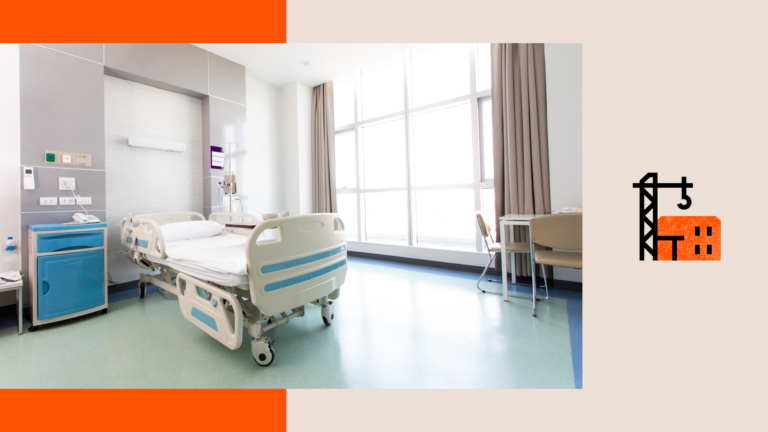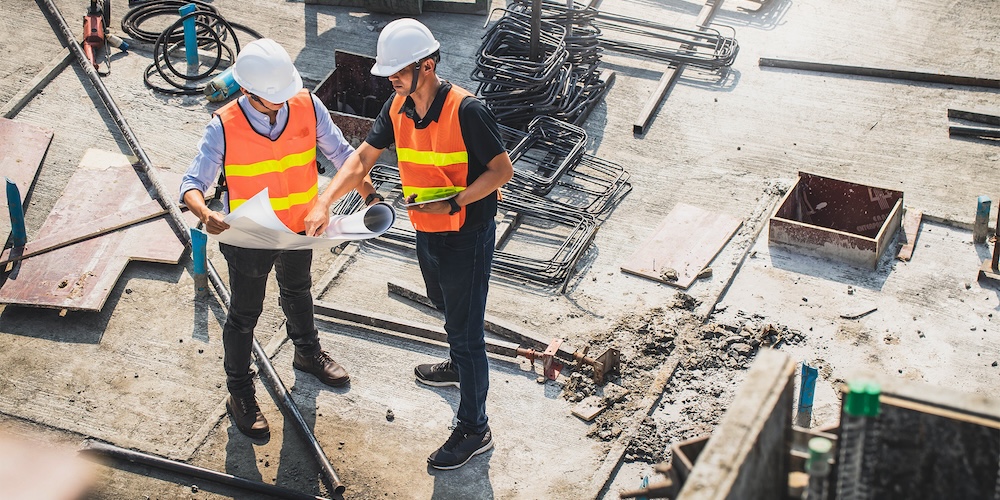— 6 min read
Hospital Building Codes: Understanding Construction Code Requirements
Last Updated Mar 25, 2025
Last Updated Mar 25, 2025

Building codes in construction represent a minimum quality standard in the built world. Creating and upholding building codes means users can trust that structures are safer and more resilient to natural disasters. Specialized building codes — like those in place for medical facilities — ensure the safety, functionality and efficiency of hospitals, and help make it possible for medical professionals to deliver high-quality healthcare.
This article will discuss building codes that are specific to hospital construction, the challenges they may pose to the construction team and how contractors can put them to use to deliver top-quality medical facilities.
Table of contents
The Purpose of Building Codes
Building codes serve multiple vital functions in healthcare construction. Primarily, they establish safety and health standards to prevent hazards like fire or structural failures.
These codes also maintain accessibility, allowing all individuals, including those with disabilities, to navigate the facility more easily. Building codes in general help maintain construction quality so hospitals are durable, sustainable and capable of accommodating technological advancements.
Key Differences Between Medical and Commercial Construction
The construction of medical facilities differs substantially from that of commercial buildings.
Medical construction demands a higher level of complexity due to stringent safety standards and specialized infrastructure requirements. For instance, hospitals require advanced HVAC systems that feature smoke control, pressurization and filtration capabilities.
Medical buildings often include reinforced structural integrity and compartmentalized structures. Some areas of a medical building need very specific features built in. For example, an X-ray suite needs to have lead lining on walls and doors.
Electrical distribution systems tend to offer multiple transfer switches in hospitals, with isolated power systems and line isolation monitors and Life Safety circuits for life support systems.
Unlike commercial buildings, hospitals must also integrate infection control measures and accommodate seamless emergency services.
Overall, patient-centered design requires hospitals to prioritize privacy, comfort and accessibility throughout the entire facility. Builders are challenged to create efficient layouts and integrate technology effectively throughout the space. By using thoughtful design, the building can help to reduce stress for both patients and healthcare providers.
Building Codes and Regulations for Healthcare Facilities
Several key codes and regulations govern healthcare facility construction. Adhering to these codes is crucial for legal compliance and successful hospital operation.
The International Building Code
The International Building Code (IBC) provides comprehensive requirements for building design, construction and maintenance. It has been widely adopted into state and federal law, so its guidelines are also applicable for healthcare facilities. The IBC sets standards for building design, construction materials, structural systems, fire safety and accessibility of buildings.
ANSI/ASHRAE/ASHE Standard 170
The American Society for Health Care Engineering (ASHE) uses code Standard 170, Ventilation of Health Care Facilities to dictate minimum air flow, humidity control and room pressure control within hospital buildings.
NFPA
The National Fire Protection Association's (NFPA) Life Safety Code (LSC) — otherwise known as the NFPA 101 — is part of the NFPA's effort to minimize the risk of fire. Specifically, it addresses requirements for fire alarms, sprinklers and safe egress from the building.
NFPA 99, also called the Health Care Facilities Code (HCFC), is a set of minimum requirements for installation, inspection, testing and maintenance for equipment and appliances. It specifies the minimum criteria for gas and vacuum systems, electric systems and hyperbaric chambers and facilities.
Along with the LSC, the HCFC requirements need to be followed for recertification under Medicare/Medicaid.
Americans with Disabilities Act (ADA)
Compliance with the Americans with Disabilities Act (ADA) makes sure a building is accessible for users with many types of special needs. ADA standards call for entrance ramps, ample doorway size that can accommodate wheelchairs and grab bars in bathrooms.
Facilities Guide Institute
The Facilities Guide Institute (FGI) publishes guidelines for planning, designing and building medical facilities. These guidelines go into architectural and design details for hospitals, outpatient facilities and residential health facilities. Although referred to as guidelines, the rules in the FGI are written as standards and are enforceable when adopted into state law.
An Example of Hospital Building Codes in Action
Consider a contractor embarking on a new hospital build. The builder works with the engineer and develops holistic plans that will take the budget and timeline into consideration, along with compliance with all necessary building codes.
Adhering to guidelines such as those from the Facility Guidelines Institute (FGI), the builder integrates features like negative pressure isolation rooms, antimicrobial surfaces and specialized HVAC systems that minimize airborne pathogens.
These measures ensure compliance with regulations but they also enhance patient safety, reduce hospital-acquired infections and improve overall healthcare outcomes. The builder prioritizes these elements from the outset, helping contribute to a safer, more efficient healthcare environment.
Challenges in Following Hospital Building Codes
Owners and builders must work together to make sure new and existing hospitals follow building codes. That can pose some challenges in balancing the budget, schedule and building requirements.
Intersecting Codes
The required building codes for medical facilities may not always be in alignment. For instance, the NFPA codes sometimes differ from guidelines provided by the ICC, and state governments can adopt even more restrictive rules. Contractors have to understand all of the codes and follow the most restrictive code requirements to resolve any differences.
Balancing Budget and Building Requirements
Balancing regulatory requirements with design and budget constraints for hospital facilities can be daunting for construction teams. Working closely among project stakeholders can help project teams balance all of the different priorities effectively.
Keeping Everyone on the Same Page
The multitude of regulations that can apply to building a new hospital can be a challenge for the many stakeholders involved in the project. Coordinating with various stakeholders, including architects, engineers and medical professionals, necessitates effective communication and collaboration.
Best Practices in Implementing Hospital Building Codes
Ongoing education, open communication with stakeholders and using digital tools to stay apprised of changes can help builders stay compliant with hospital building codes.
Stay on Top of Changing Rules
Healthcare regulations are continually evolving, reflecting advancements in technology and changing societal needs. Contractors and facility managers can help buildings stay compliant by keeping informed and flexible to new challenges. Continuous education can help builders keep pace with new standards, as can software tools that help identify applicable standards and codes.
Engage with Industry Associations
Joining professional associations such as the American Society for Healthcare Engineering or the Facilities Guidelines Institute can provide access to valuable resources, updates and networking opportunities that can help builders learn how to stay compliant with hospital building codes while achieving the best possible outcomes.
Improve Outcomes by Working with Specialty Contractors
Building healthcare facilities is a specialized niche within the construction industry. The complexity of hospital construction underscores the importance of specialized contractors. Experience navigating the stringent and often-changing requirements for hospital building, maintaining compliance with evolving safety and health standards and ensuring that the facility meets all operational needs.
Courses about construction.
For construction.
Unlock your career potential with our free educational courses on Health & Safety, Data in Construction, and more.
Using Hospital Building Codes for Optimal Outcomes
Understanding and adhering to building codes is fundamental in hospital construction, ensuring safety, functionality and efficiency. As healthcare regulations continue to evolve, staying informed and adaptable is crucial for addressing the challenges and opportunities in this dynamic field. By prioritizing patient care, staff efficiency and sustainability, healthcare construction can support the delivery of high-quality medical services, now and in the future.
Was this article helpful?
Thank you for your submission.
0%
0%
You voted that this article was . Was this a mistake? If so, change your vote here.
Scroll less, learn more about construction.
Subscribe to The Blueprint, Procore’s construction newsletter, to get content from industry experts delivered straight to your inbox.
By clicking this button, you agree to our Privacy Notice and Terms of Service.
Categories:
Tags:
Written by
Kristen Frisa
66 articles
Kristen Frisa is a contributing writer for Procore. She also contributes to a variety of industry publications as a freelance writer focused on finance and construction technology. Kristen holds a Bachelor of Arts in Philosophy and History from Western University, with a post-graduate certificate in journalism from Sheridan College. She lives in Ontario, Canada.
View profileExplore more helpful resources

12 Common RFP Mistakes (and How to Avoid Them)
Responding to a request for proposal (RFP) demands time, coordination and expertise across an AEC firm. It’s a complex process that requires teams to balance precision with persuasion, often under...

Trade Stacking: Preventing & Managing Trade Clashes
When construction projects fall behind schedule, adding more workers may seem like a logical solution. However, when multiple trades are forced to operate in the same confined space simultaneously, the...

How BIM Enhances Control and Efficiency for Project Owners
Any construction project has a number of stakeholders. With a traditional project delivery method, it moves from designers and engineers in the architectural design process, to the general contractor and...

Optimizing Solar Inspections: A Construction Pro’s Guide
As solar power becomes more prevalent in both residential and commercial projects, construction contractors and project owners will need to become more familiar with solar installation projects. Solar inspections —...